Asthma Management: Clinical Manifestations, Treatment, and Education
VerifiedAdded on 2021/06/16
|7
|1545
|45
Report
AI Summary
This report provides a comprehensive overview of asthma management, beginning with the clinical manifestations of allergic rhinitis in a case study patient, Tegan Smith, and exploring the environmental and genetic factors contributing to the condition. It then delves into the pathophysiology of asthma, highlighting airway inflammation, immune cell infiltration, and the role of mediators like histamines and leukotrienes. The report discusses the importance of clinical assessment, including patient history and environmental factors, in developing effective asthma management plans. Essential medications, such as antileukotrienes and corticosteroids, are outlined, along with the goals of treatment: improving airway function and mitigating exacerbations. The report emphasizes the crucial role of patient education, including self-management techniques, proper use of inhalers and nebulizers, and adherence to medication regimens. The importance of a written asthma plan, detection of peak expiratory flows, and avoiding triggers is also discussed. Furthermore, it highlights the significance of family education, especially in pediatric cases, and the need for nutritional assessment. References to key guidelines and research articles are included to support the information presented.
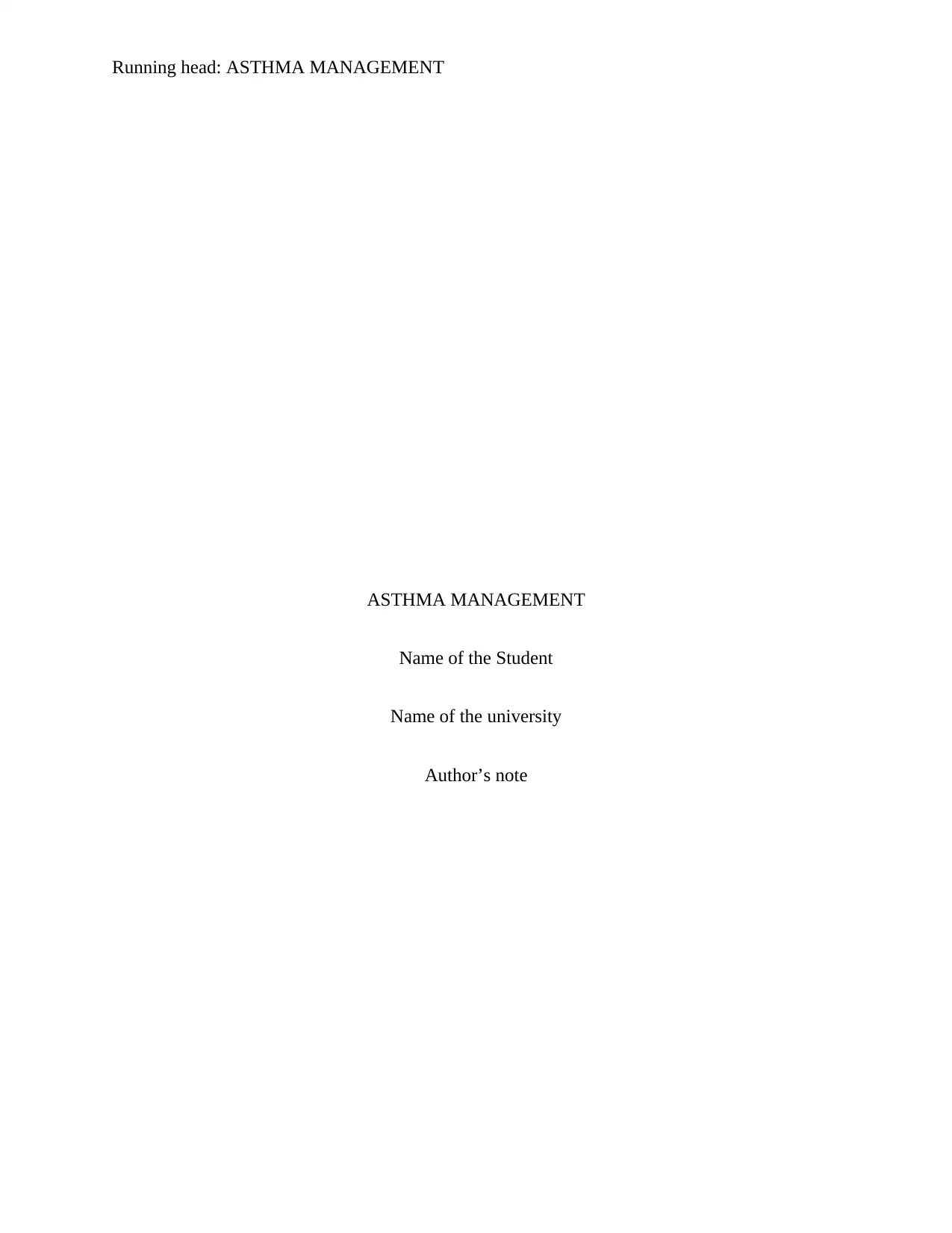
Running head: ASTHMA MANAGEMENT
ASTHMA MANAGEMENT
Name of the Student
Name of the university
Author’s note
ASTHMA MANAGEMENT
Name of the Student
Name of the university
Author’s note
Paraphrase This Document
Need a fresh take? Get an instant paraphrase of this document with our AI Paraphraser
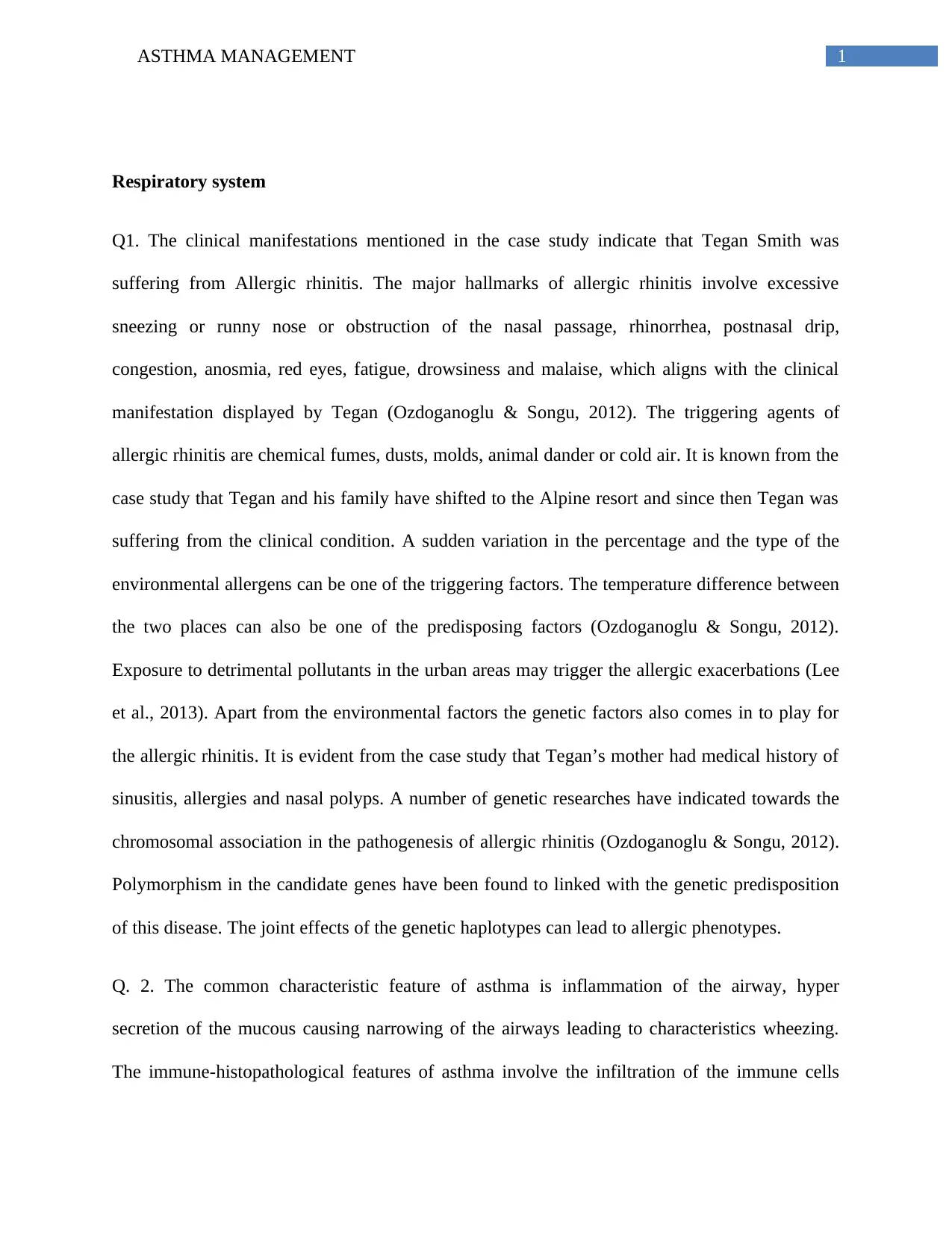
1ASTHMA MANAGEMENT
Respiratory system
Q1. The clinical manifestations mentioned in the case study indicate that Tegan Smith was
suffering from Allergic rhinitis. The major hallmarks of allergic rhinitis involve excessive
sneezing or runny nose or obstruction of the nasal passage, rhinorrhea, postnasal drip,
congestion, anosmia, red eyes, fatigue, drowsiness and malaise, which aligns with the clinical
manifestation displayed by Tegan (Ozdoganoglu & Songu, 2012). The triggering agents of
allergic rhinitis are chemical fumes, dusts, molds, animal dander or cold air. It is known from the
case study that Tegan and his family have shifted to the Alpine resort and since then Tegan was
suffering from the clinical condition. A sudden variation in the percentage and the type of the
environmental allergens can be one of the triggering factors. The temperature difference between
the two places can also be one of the predisposing factors (Ozdoganoglu & Songu, 2012).
Exposure to detrimental pollutants in the urban areas may trigger the allergic exacerbations (Lee
et al., 2013). Apart from the environmental factors the genetic factors also comes in to play for
the allergic rhinitis. It is evident from the case study that Tegan’s mother had medical history of
sinusitis, allergies and nasal polyps. A number of genetic researches have indicated towards the
chromosomal association in the pathogenesis of allergic rhinitis (Ozdoganoglu & Songu, 2012).
Polymorphism in the candidate genes have been found to linked with the genetic predisposition
of this disease. The joint effects of the genetic haplotypes can lead to allergic phenotypes.
Q. 2. The common characteristic feature of asthma is inflammation of the airway, hyper
secretion of the mucous causing narrowing of the airways leading to characteristics wheezing.
The immune-histopathological features of asthma involve the infiltration of the immune cells
Respiratory system
Q1. The clinical manifestations mentioned in the case study indicate that Tegan Smith was
suffering from Allergic rhinitis. The major hallmarks of allergic rhinitis involve excessive
sneezing or runny nose or obstruction of the nasal passage, rhinorrhea, postnasal drip,
congestion, anosmia, red eyes, fatigue, drowsiness and malaise, which aligns with the clinical
manifestation displayed by Tegan (Ozdoganoglu & Songu, 2012). The triggering agents of
allergic rhinitis are chemical fumes, dusts, molds, animal dander or cold air. It is known from the
case study that Tegan and his family have shifted to the Alpine resort and since then Tegan was
suffering from the clinical condition. A sudden variation in the percentage and the type of the
environmental allergens can be one of the triggering factors. The temperature difference between
the two places can also be one of the predisposing factors (Ozdoganoglu & Songu, 2012).
Exposure to detrimental pollutants in the urban areas may trigger the allergic exacerbations (Lee
et al., 2013). Apart from the environmental factors the genetic factors also comes in to play for
the allergic rhinitis. It is evident from the case study that Tegan’s mother had medical history of
sinusitis, allergies and nasal polyps. A number of genetic researches have indicated towards the
chromosomal association in the pathogenesis of allergic rhinitis (Ozdoganoglu & Songu, 2012).
Polymorphism in the candidate genes have been found to linked with the genetic predisposition
of this disease. The joint effects of the genetic haplotypes can lead to allergic phenotypes.
Q. 2. The common characteristic feature of asthma is inflammation of the airway, hyper
secretion of the mucous causing narrowing of the airways leading to characteristics wheezing.
The immune-histopathological features of asthma involve the infiltration of the immune cells
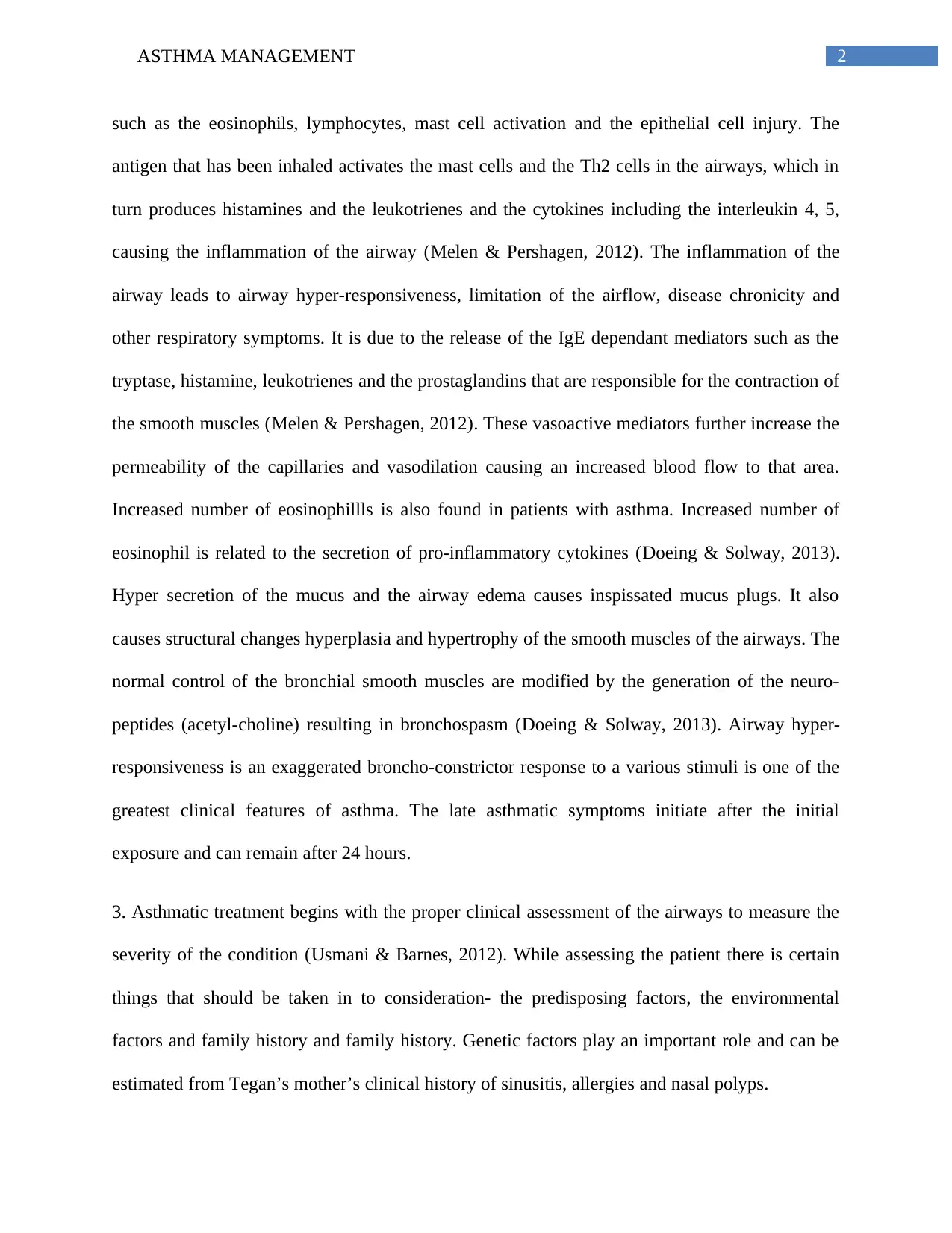
2ASTHMA MANAGEMENT
such as the eosinophils, lymphocytes, mast cell activation and the epithelial cell injury. The
antigen that has been inhaled activates the mast cells and the Th2 cells in the airways, which in
turn produces histamines and the leukotrienes and the cytokines including the interleukin 4, 5,
causing the inflammation of the airway (Melen & Pershagen, 2012). The inflammation of the
airway leads to airway hyper-responsiveness, limitation of the airflow, disease chronicity and
other respiratory symptoms. It is due to the release of the IgE dependant mediators such as the
tryptase, histamine, leukotrienes and the prostaglandins that are responsible for the contraction of
the smooth muscles (Melen & Pershagen, 2012). These vasoactive mediators further increase the
permeability of the capillaries and vasodilation causing an increased blood flow to that area.
Increased number of eosinophillls is also found in patients with asthma. Increased number of
eosinophil is related to the secretion of pro-inflammatory cytokines (Doeing & Solway, 2013).
Hyper secretion of the mucus and the airway edema causes inspissated mucus plugs. It also
causes structural changes hyperplasia and hypertrophy of the smooth muscles of the airways. The
normal control of the bronchial smooth muscles are modified by the generation of the neuro-
peptides (acetyl-choline) resulting in bronchospasm (Doeing & Solway, 2013). Airway hyper-
responsiveness is an exaggerated broncho-constrictor response to a various stimuli is one of the
greatest clinical features of asthma. The late asthmatic symptoms initiate after the initial
exposure and can remain after 24 hours.
3. Asthmatic treatment begins with the proper clinical assessment of the airways to measure the
severity of the condition (Usmani & Barnes, 2012). While assessing the patient there is certain
things that should be taken in to consideration- the predisposing factors, the environmental
factors and family history and family history. Genetic factors play an important role and can be
estimated from Tegan’s mother’s clinical history of sinusitis, allergies and nasal polyps.
such as the eosinophils, lymphocytes, mast cell activation and the epithelial cell injury. The
antigen that has been inhaled activates the mast cells and the Th2 cells in the airways, which in
turn produces histamines and the leukotrienes and the cytokines including the interleukin 4, 5,
causing the inflammation of the airway (Melen & Pershagen, 2012). The inflammation of the
airway leads to airway hyper-responsiveness, limitation of the airflow, disease chronicity and
other respiratory symptoms. It is due to the release of the IgE dependant mediators such as the
tryptase, histamine, leukotrienes and the prostaglandins that are responsible for the contraction of
the smooth muscles (Melen & Pershagen, 2012). These vasoactive mediators further increase the
permeability of the capillaries and vasodilation causing an increased blood flow to that area.
Increased number of eosinophillls is also found in patients with asthma. Increased number of
eosinophil is related to the secretion of pro-inflammatory cytokines (Doeing & Solway, 2013).
Hyper secretion of the mucus and the airway edema causes inspissated mucus plugs. It also
causes structural changes hyperplasia and hypertrophy of the smooth muscles of the airways. The
normal control of the bronchial smooth muscles are modified by the generation of the neuro-
peptides (acetyl-choline) resulting in bronchospasm (Doeing & Solway, 2013). Airway hyper-
responsiveness is an exaggerated broncho-constrictor response to a various stimuli is one of the
greatest clinical features of asthma. The late asthmatic symptoms initiate after the initial
exposure and can remain after 24 hours.
3. Asthmatic treatment begins with the proper clinical assessment of the airways to measure the
severity of the condition (Usmani & Barnes, 2012). While assessing the patient there is certain
things that should be taken in to consideration- the predisposing factors, the environmental
factors and family history and family history. Genetic factors play an important role and can be
estimated from Tegan’s mother’s clinical history of sinusitis, allergies and nasal polyps.
⊘ This is a preview!⊘
Do you want full access?
Subscribe today to unlock all pages.

Trusted by 1+ million students worldwide
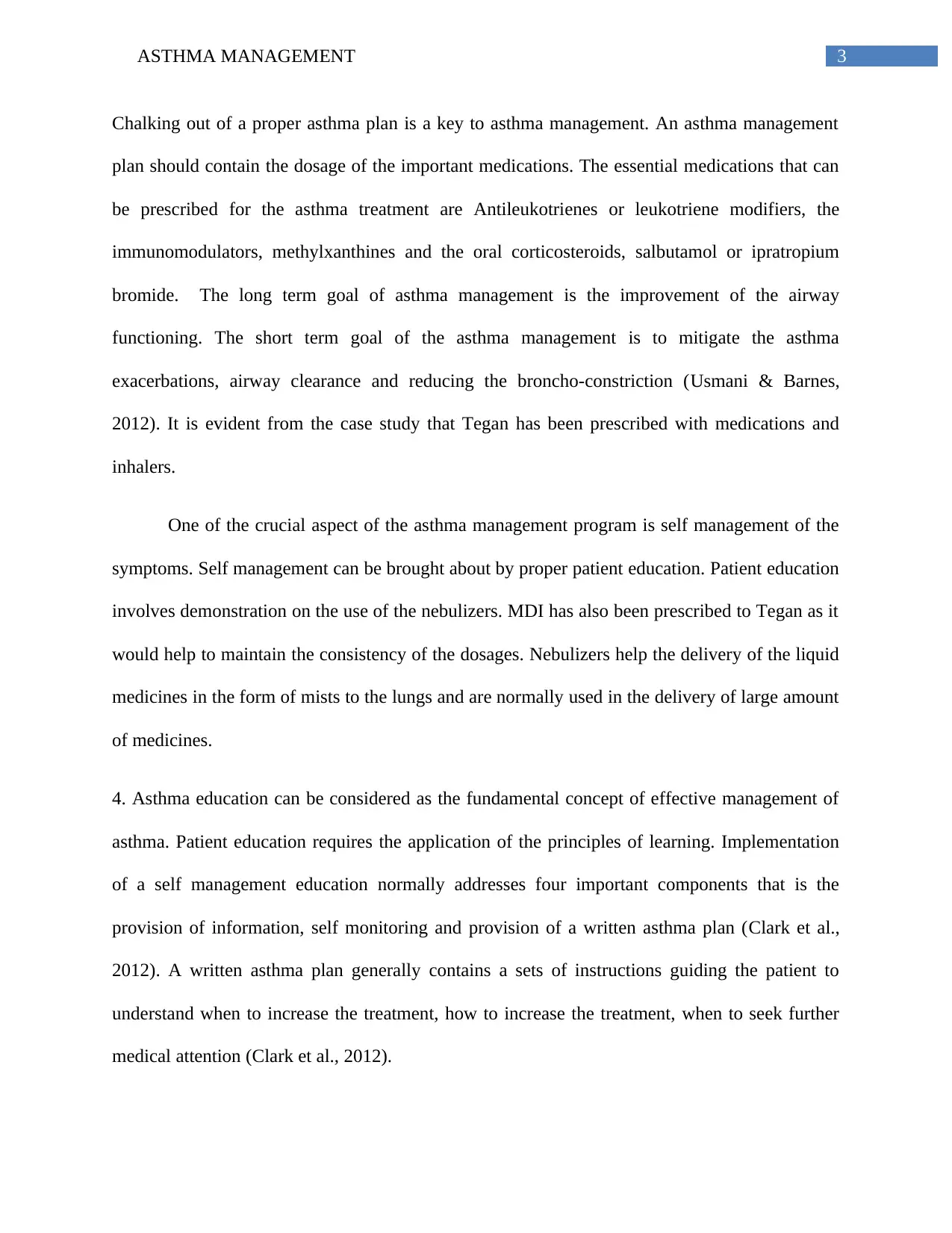
3ASTHMA MANAGEMENT
Chalking out of a proper asthma plan is a key to asthma management. An asthma management
plan should contain the dosage of the important medications. The essential medications that can
be prescribed for the asthma treatment are Antileukotrienes or leukotriene modifiers, the
immunomodulators, methylxanthines and the oral corticosteroids, salbutamol or ipratropium
bromide. The long term goal of asthma management is the improvement of the airway
functioning. The short term goal of the asthma management is to mitigate the asthma
exacerbations, airway clearance and reducing the broncho-constriction (Usmani & Barnes,
2012). It is evident from the case study that Tegan has been prescribed with medications and
inhalers.
One of the crucial aspect of the asthma management program is self management of the
symptoms. Self management can be brought about by proper patient education. Patient education
involves demonstration on the use of the nebulizers. MDI has also been prescribed to Tegan as it
would help to maintain the consistency of the dosages. Nebulizers help the delivery of the liquid
medicines in the form of mists to the lungs and are normally used in the delivery of large amount
of medicines.
4. Asthma education can be considered as the fundamental concept of effective management of
asthma. Patient education requires the application of the principles of learning. Implementation
of a self management education normally addresses four important components that is the
provision of information, self monitoring and provision of a written asthma plan (Clark et al.,
2012). A written asthma plan generally contains a sets of instructions guiding the patient to
understand when to increase the treatment, how to increase the treatment, when to seek further
medical attention (Clark et al., 2012).
Chalking out of a proper asthma plan is a key to asthma management. An asthma management
plan should contain the dosage of the important medications. The essential medications that can
be prescribed for the asthma treatment are Antileukotrienes or leukotriene modifiers, the
immunomodulators, methylxanthines and the oral corticosteroids, salbutamol or ipratropium
bromide. The long term goal of asthma management is the improvement of the airway
functioning. The short term goal of the asthma management is to mitigate the asthma
exacerbations, airway clearance and reducing the broncho-constriction (Usmani & Barnes,
2012). It is evident from the case study that Tegan has been prescribed with medications and
inhalers.
One of the crucial aspect of the asthma management program is self management of the
symptoms. Self management can be brought about by proper patient education. Patient education
involves demonstration on the use of the nebulizers. MDI has also been prescribed to Tegan as it
would help to maintain the consistency of the dosages. Nebulizers help the delivery of the liquid
medicines in the form of mists to the lungs and are normally used in the delivery of large amount
of medicines.
4. Asthma education can be considered as the fundamental concept of effective management of
asthma. Patient education requires the application of the principles of learning. Implementation
of a self management education normally addresses four important components that is the
provision of information, self monitoring and provision of a written asthma plan (Clark et al.,
2012). A written asthma plan generally contains a sets of instructions guiding the patient to
understand when to increase the treatment, how to increase the treatment, when to seek further
medical attention (Clark et al., 2012).
Paraphrase This Document
Need a fresh take? Get an instant paraphrase of this document with our AI Paraphraser
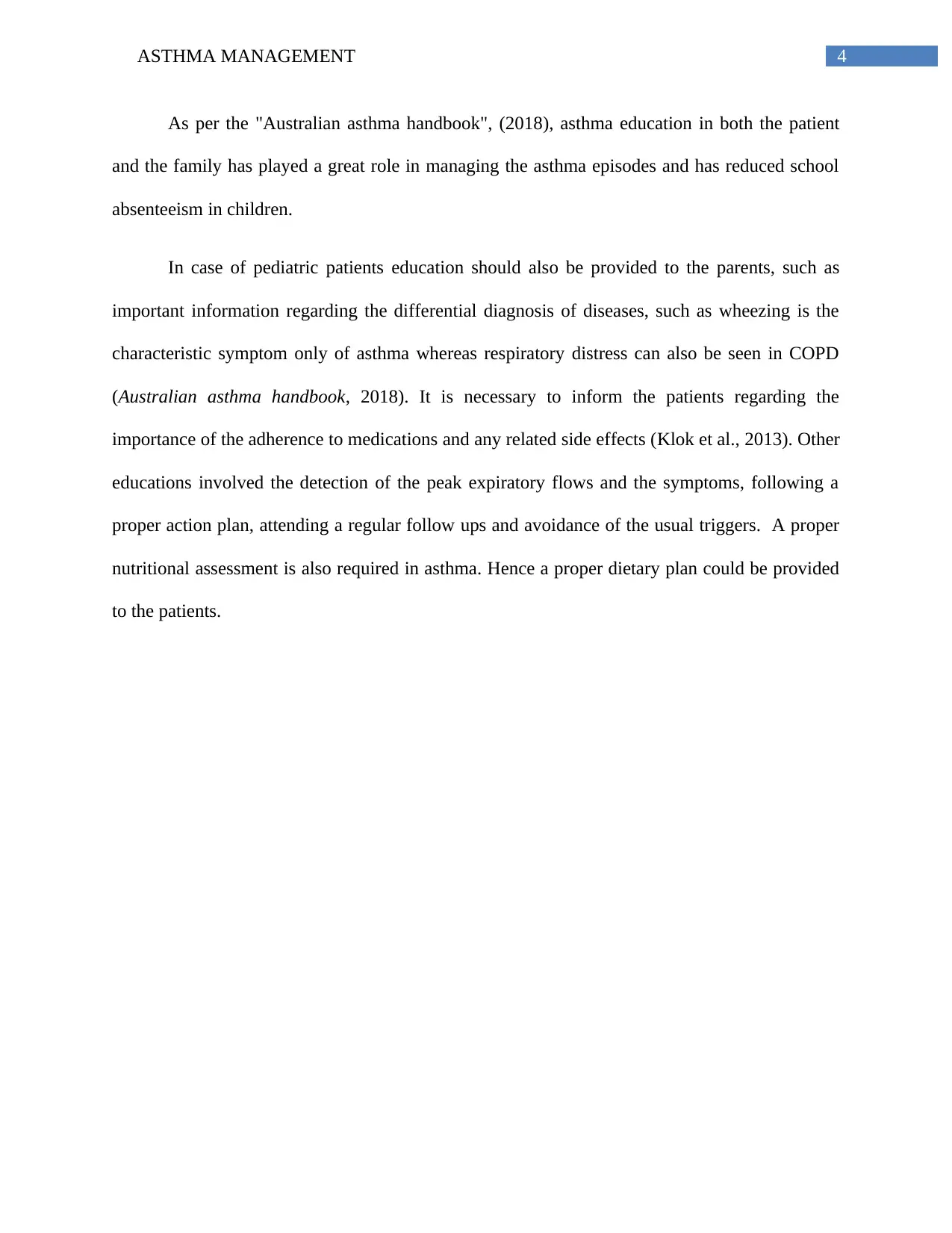
4ASTHMA MANAGEMENT
As per the "Australian asthma handbook", (2018), asthma education in both the patient
and the family has played a great role in managing the asthma episodes and has reduced school
absenteeism in children.
In case of pediatric patients education should also be provided to the parents, such as
important information regarding the differential diagnosis of diseases, such as wheezing is the
characteristic symptom only of asthma whereas respiratory distress can also be seen in COPD
(Australian asthma handbook, 2018). It is necessary to inform the patients regarding the
importance of the adherence to medications and any related side effects (Klok et al., 2013). Other
educations involved the detection of the peak expiratory flows and the symptoms, following a
proper action plan, attending a regular follow ups and avoidance of the usual triggers. A proper
nutritional assessment is also required in asthma. Hence a proper dietary plan could be provided
to the patients.
As per the "Australian asthma handbook", (2018), asthma education in both the patient
and the family has played a great role in managing the asthma episodes and has reduced school
absenteeism in children.
In case of pediatric patients education should also be provided to the parents, such as
important information regarding the differential diagnosis of diseases, such as wheezing is the
characteristic symptom only of asthma whereas respiratory distress can also be seen in COPD
(Australian asthma handbook, 2018). It is necessary to inform the patients regarding the
importance of the adherence to medications and any related side effects (Klok et al., 2013). Other
educations involved the detection of the peak expiratory flows and the symptoms, following a
proper action plan, attending a regular follow ups and avoidance of the usual triggers. A proper
nutritional assessment is also required in asthma. Hence a proper dietary plan could be provided
to the patients.
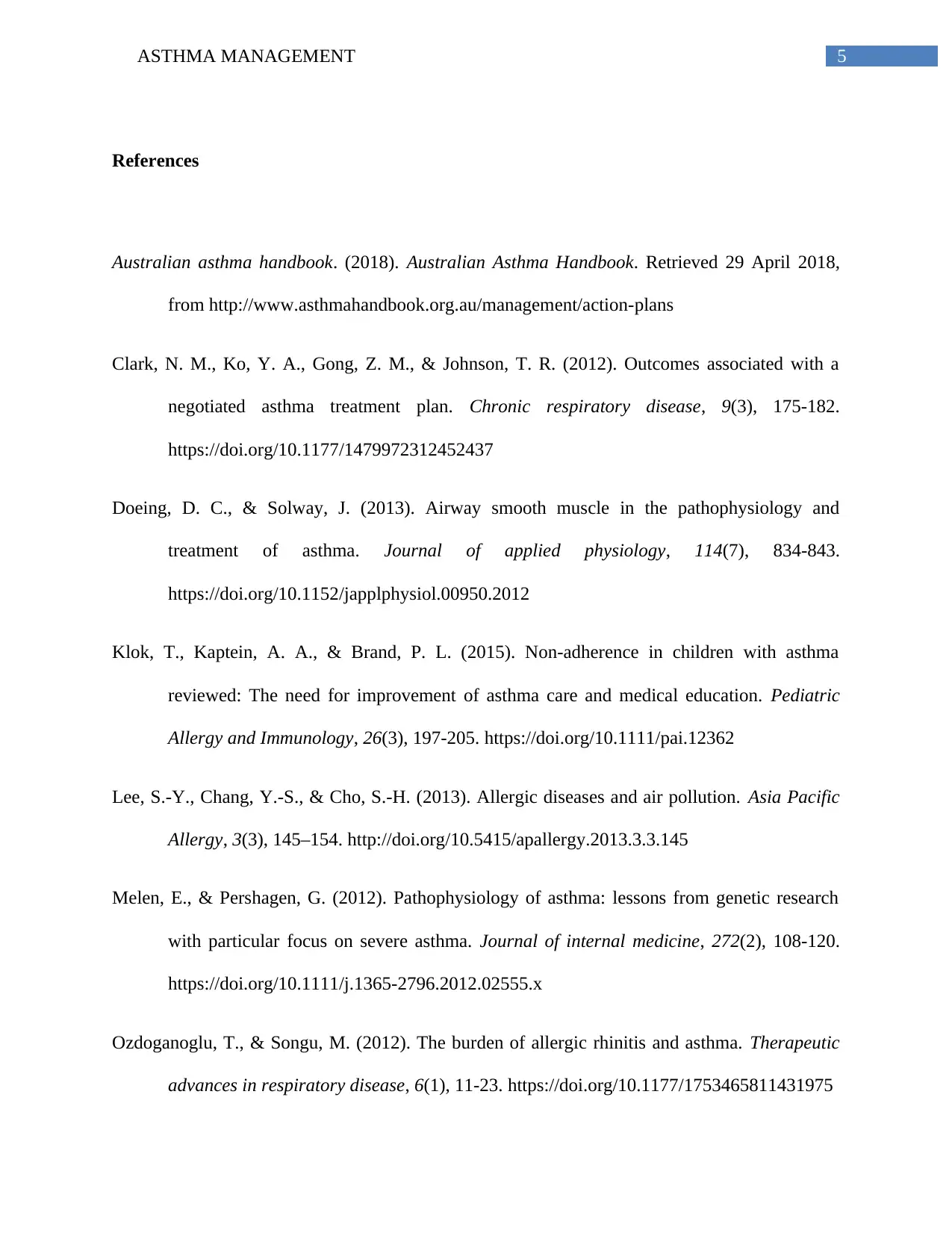
5ASTHMA MANAGEMENT
References
Australian asthma handbook. (2018). Australian Asthma Handbook. Retrieved 29 April 2018,
from http://www.asthmahandbook.org.au/management/action-plans
Clark, N. M., Ko, Y. A., Gong, Z. M., & Johnson, T. R. (2012). Outcomes associated with a
negotiated asthma treatment plan. Chronic respiratory disease, 9(3), 175-182.
https://doi.org/10.1177/1479972312452437
Doeing, D. C., & Solway, J. (2013). Airway smooth muscle in the pathophysiology and
treatment of asthma. Journal of applied physiology, 114(7), 834-843.
https://doi.org/10.1152/japplphysiol.00950.2012
Klok, T., Kaptein, A. A., & Brand, P. L. (2015). Non‐adherence in children with asthma
reviewed: The need for improvement of asthma care and medical education. Pediatric
Allergy and Immunology, 26(3), 197-205. https://doi.org/10.1111/pai.12362
Lee, S.-Y., Chang, Y.-S., & Cho, S.-H. (2013). Allergic diseases and air pollution. Asia Pacific
Allergy, 3(3), 145–154. http://doi.org/10.5415/apallergy.2013.3.3.145
Melen, E., & Pershagen, G. (2012). Pathophysiology of asthma: lessons from genetic research
with particular focus on severe asthma. Journal of internal medicine, 272(2), 108-120.
https://doi.org/10.1111/j.1365-2796.2012.02555.x
Ozdoganoglu, T., & Songu, M. (2012). The burden of allergic rhinitis and asthma. Therapeutic
advances in respiratory disease, 6(1), 11-23. https://doi.org/10.1177/1753465811431975
References
Australian asthma handbook. (2018). Australian Asthma Handbook. Retrieved 29 April 2018,
from http://www.asthmahandbook.org.au/management/action-plans
Clark, N. M., Ko, Y. A., Gong, Z. M., & Johnson, T. R. (2012). Outcomes associated with a
negotiated asthma treatment plan. Chronic respiratory disease, 9(3), 175-182.
https://doi.org/10.1177/1479972312452437
Doeing, D. C., & Solway, J. (2013). Airway smooth muscle in the pathophysiology and
treatment of asthma. Journal of applied physiology, 114(7), 834-843.
https://doi.org/10.1152/japplphysiol.00950.2012
Klok, T., Kaptein, A. A., & Brand, P. L. (2015). Non‐adherence in children with asthma
reviewed: The need for improvement of asthma care and medical education. Pediatric
Allergy and Immunology, 26(3), 197-205. https://doi.org/10.1111/pai.12362
Lee, S.-Y., Chang, Y.-S., & Cho, S.-H. (2013). Allergic diseases and air pollution. Asia Pacific
Allergy, 3(3), 145–154. http://doi.org/10.5415/apallergy.2013.3.3.145
Melen, E., & Pershagen, G. (2012). Pathophysiology of asthma: lessons from genetic research
with particular focus on severe asthma. Journal of internal medicine, 272(2), 108-120.
https://doi.org/10.1111/j.1365-2796.2012.02555.x
Ozdoganoglu, T., & Songu, M. (2012). The burden of allergic rhinitis and asthma. Therapeutic
advances in respiratory disease, 6(1), 11-23. https://doi.org/10.1177/1753465811431975
⊘ This is a preview!⊘
Do you want full access?
Subscribe today to unlock all pages.

Trusted by 1+ million students worldwide
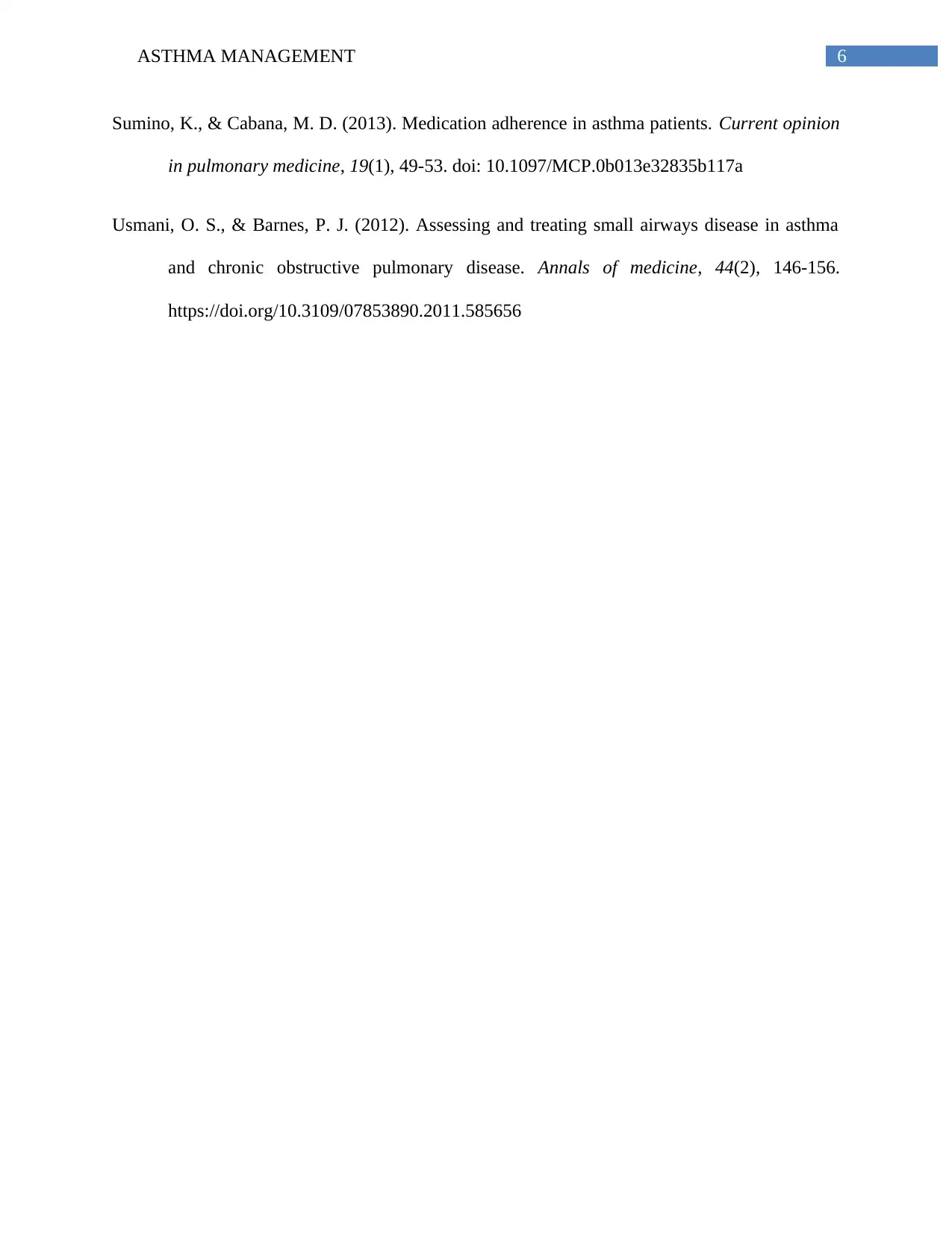
6ASTHMA MANAGEMENT
Sumino, K., & Cabana, M. D. (2013). Medication adherence in asthma patients. Current opinion
in pulmonary medicine, 19(1), 49-53. doi: 10.1097/MCP.0b013e32835b117a
Usmani, O. S., & Barnes, P. J. (2012). Assessing and treating small airways disease in asthma
and chronic obstructive pulmonary disease. Annals of medicine, 44(2), 146-156.
https://doi.org/10.3109/07853890.2011.585656
Sumino, K., & Cabana, M. D. (2013). Medication adherence in asthma patients. Current opinion
in pulmonary medicine, 19(1), 49-53. doi: 10.1097/MCP.0b013e32835b117a
Usmani, O. S., & Barnes, P. J. (2012). Assessing and treating small airways disease in asthma
and chronic obstructive pulmonary disease. Annals of medicine, 44(2), 146-156.
https://doi.org/10.3109/07853890.2011.585656
1 out of 7
Related Documents
Your All-in-One AI-Powered Toolkit for Academic Success.
+13062052269
info@desklib.com
Available 24*7 on WhatsApp / Email
![[object Object]](/_next/static/media/star-bottom.7253800d.svg)
Unlock your academic potential
Copyright © 2020–2025 A2Z Services. All Rights Reserved. Developed and managed by ZUCOL.





